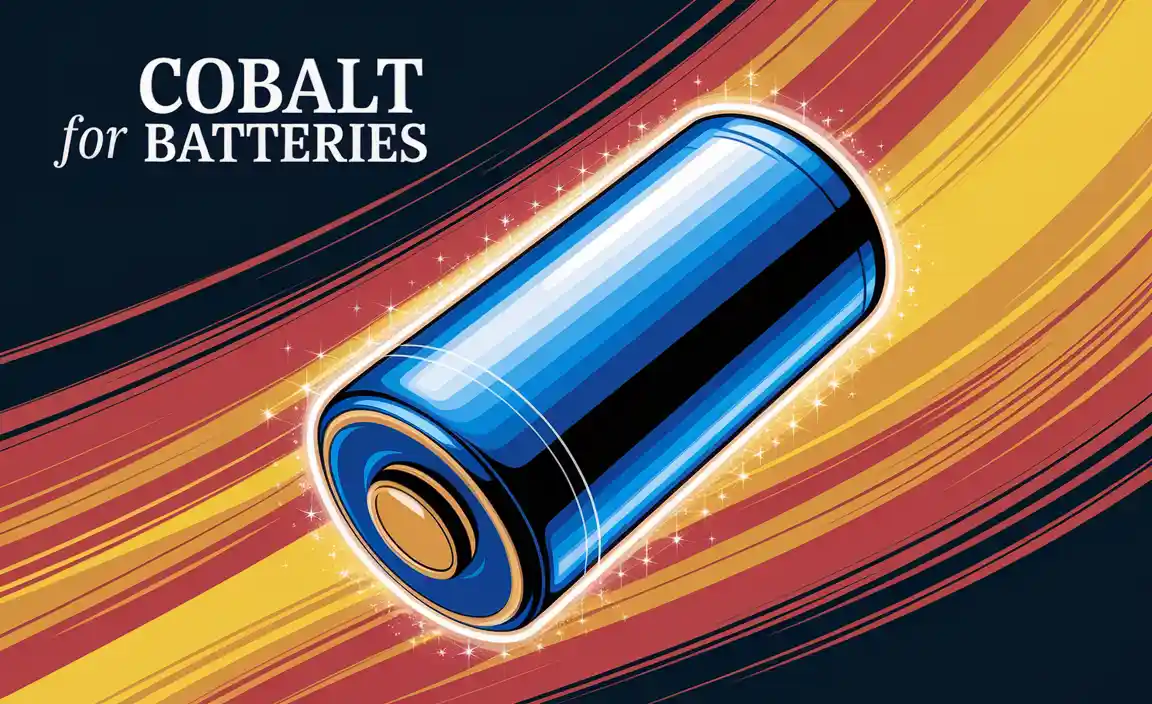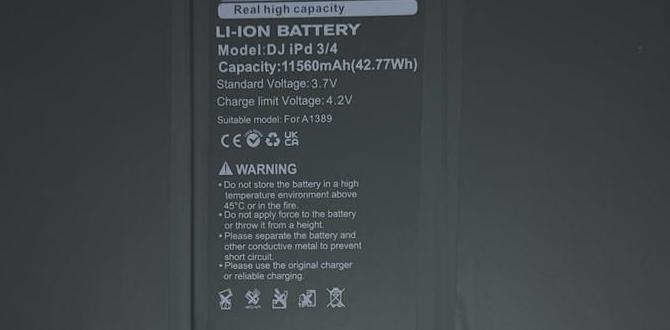Have you ever wondered what makes your electric toys or gadgets work? One key element is cobalt, a shiny blue metal found deep in the Earth. Cobalt is an essential ingredient in many batteries that power our favorite devices.
Cobalt helps batteries store energy and stay safe. Without it, your phone might not last a whole day! Isn’t it amazing to think that something so small can make such a big difference?

Many people don’t realize cobalt is special. It is not just for batteries, but also for electric cars and even some renewable energy sources. As we move towards a greener world, understanding cobalt becomes more important.
Are you curious about how this metal travels from mines to your gadgets? Join us as we explore the journey of cobalt for batteries and why it matters to you!
Cobalt For Batteries: Essential Material For Energy Storage
Cobalt for Batteries
Cobalt plays a key role in modern batteries, especially in electric vehicles. It helps improve battery safety and lifespan. Did you know that cobalt can increase energy density too? This means batteries can store more power in less space. As demand for electric cars grows, so does the need for cobalt. But where does it come from? Most cobalt is mined in the Democratic Republic of Congo. This has sparked discussions about sustainable sourcing.
What is Cobalt and Its Role in Batteries?
Definition and chemical properties of cobalt. Importance of cobalt in lithiumion battery chemistry.
Cobalt is a shiny, bluish-gray metal. It likes to hang out with other elements in nature. It has unique properties, like being strong and resistant to heat. These traits make it super valuable for batteries, especially lithium-ion ones. Cobalt helps batteries store and release energy efficiently, making your gadgets run smoothly. Without cobalt, your phone might just be a fancy paperweight!
| Property | Description |
|---|---|
| Atomic Number | 27 |
| Melting Point | 1495°C (2723°F) |
| Density | 8.90 g/cm³ |
In lithium-ion battery chemistry, cobalt plays the role of the reliable sidekick. It stabilizes the battery, helping it last longer. Studies show that batteries with cobalt can improve capacity by up to 20%. So next time your device is buzzing, thank cobalt for keeping it alive and kicking!
Sources of Cobalt
Primary mining locations and production statistics. Ethical considerations and supply chain issues.
Cobalt is mostly found in places like the Democratic Republic of the Congo (DRC), which produces over 60% of the world’s supply. Other locations include Canada and Australia. However, mining isn’t without issues. Many mines have poor working conditions and child labor. It’s a bit like finding out your favorite candy is made in a factory where kids pack them in. Yikes!
| Location | Production (% of Global) |
|---|---|
| Democratic Republic of the Congo | 60% |
| Canada | 4% |
| Australia | 2% |
Watching the supply chain of cobalt can feel like a roller coaster. While we need cobalt for our gadgets and electric cars, we must also ensure it is sourced ethically. We want to power our devices without frowning over where they come from!
Cobalt’s Impact on Battery Performance
Effects of cobalt on energy density and longevity. Comparison with other materials used in batteries.
Cobalt plays a big role in how batteries work. It helps make batteries store more energy, which is called energy density. This means you can use your devices longer without charging them often. Cobalt also helps batteries last a long time, giving them a longer lifespan. Compared to other materials like nickel or lithium, cobalt can improve performance but often at a higher cost. Each material has its pros and cons, but cobalt remains an important choice for many battery makers.
What makes cobalt special for batteries?
Cobalt increases energy density and allows batteries to last longer than some other materials.
Key Points:
- Cobalt improves energy density.
- It increases the longevity of batteries.
- Other materials may be cheaper but have less performance.
Current Market Trends for Cobalt in Battery Production
Analysis of demand and pricing trends. Role of cobalt in the renewable energy transition.
The market for cobalt is buzzing, especially for battery production! Demand for cobalt has spiked due to the growing need for electric vehicles (EVs) and renewable energy solutions. Prices are like a roller coaster ride: they go up, then down, and sometimes upside down! In 2023, cobalt prices reached around $35,000 per ton. This metal plays a crucial role in making batteries last longer and charge faster. Without it, we might be back to driving Flintstone cars!
| Year | Cobalt Price ($/ton) | Demand (Metric Tons) |
|---|---|---|
| 2021 | $22,000 | 120,000 |
| 2022 | $30,000 | 150,000 |
| 2023 | $35,000 | 180,000 |
Cobalt is truly a superstar in the renewable energy shift. As people hop on the green train, cobalt ensures our batteries keep up. It’s like the secret sauce that makes everything work better! So, next time you see a shiny electric car zooming by, remember: it’s all thanks to our friend, cobalt!
Alternative Materials to Cobalt in Battery Technology
Innovations in battery chemistry reducing cobalt usage. Benefits and challenges of substitutes.
Battery makers are cooking up new formulas that cut down on cobalt, and it’s like a science fair project gone wild! They are exploring materials like lithium iron phosphate and sodium-ion. These substitutes can help reduce costs and dependency on cobalt, which is great unless you have a pet rock that gets jealous! But let’s face it, they also bring some challenges like lower energy density and longer charging times. It’s like trying to fit a large pizza in a tiny oven. Here’s a quick look at the pros and cons:
| Material | Benefits | Challenges |
|---|---|---|
| Lithium Iron Phosphate | Lower cost, safe | Lower energy density |
| Sodium-Ion | Abundant supply | Still in development |
Innovations are essential for a greener future. Battery technology is like a big puzzle, and every piece counts!
Environmental and Social Implications of Cobalt Mining
Environmental concerns associated with cobalt extraction. Human rights issues related to mining practices.
Cobalt mining can hurt our planet and people. Environmental issues arise when land is destroyed and rivers are polluted. Animals and plants lose their homes. Humans also face serious dangers. Many workers in mines do not get paid fairly or work in safe places. Some children even mine for cobalt. This is not right. Mining laws are needed to protect both the earth and workers.
- Pollution: Mining creates waste that harms water.
- Deforestation: Trees are cut down to make roads for mining.
- Child labor: Young children are forced to work, not go to school.
- Poor safety: Workers often suffer injuries with no help.
What are the human rights issues related to cobalt mining?
Humans face unsafe working conditions, unfair wages, and child labor in cobalt mines.
Future Outlook: Cobalt in Battery Technology
Predictions for cobalt demand in the next decade. Emerging technologies that may influence cobalt usage in batteries.
The demand for cobalt in batteries is predicted to grow. As electric vehicles and renewable energy sources increase, the need for cobalt will rise. Emerging technologies may also change how we use cobalt. These include:
- Improved battery designs that use less cobalt.
- Alternative materials that might replace cobalt.
- Recycling methods to reuse cobalt efficiently.
Experts believe that by 2030, cobalt demand could double. This will depend on how quickly new technologies develop. As we look ahead, cobalt will play a key role in energy storage solutions.
What is the future demand for cobalt?
The demand for cobalt in the battery industry is expected to increase significantly over the next decade. This growth is linked to electric vehicles and new energy technologies.
Conclusion
Cobalt is essential for making powerful batteries, especially in electric cars. It helps batteries last longer and charge faster. However, mining cobalt can harm the environment and workers. You can support better practices by choosing brands that prioritize ethical sourcing. To learn more about cobalt’s role in technology, explore articles and documentaries on sustainable energy practices.
FAQs
What Role Does Cobalt Play In Enhancing The Performance Of Lithium-Ion Batteries?
Cobalt helps make lithium-ion batteries work better. It keeps the battery stable and increases its energy storage. This means your phone or toy can run longer without needing to recharge. Cobalt also helps batteries charge faster, so you can use your devices sooner. Overall, cobalt is important for making batteries stronger and more efficient.
How Is The Mining And Sourcing Of Cobalt Impacting Environmental And Ethical Standards In Battery Production?
Mining cobalt can hurt the environment. It often damages land and water, making it hard for plants and animals to survive. Sadly, some workers, including kids, face dangerous conditions and low pay. We need to ensure that cobalt is mined safely and fairly to keep everyone healthy and happy.
What Are The Potential Alternatives To Cobalt In Battery Technology, And How Do They Compare In Terms Of Efficiency And Safety?
We can use alternatives like nickel, iron, or lithium instead of cobalt in batteries. Nickel batteries are powerful and can store a lot of energy. Iron is cheaper and safer, but it doesn’t hold as much energy. Lithium is light and efficient, making it a good choice too. Each option has pros and cons, so scientists are still exploring the best fit!
How Has The Demand For Cobalt In Electric Vehicle Batteries Affected Global Supply Chains And Market Prices?
The demand for cobalt in electric vehicle batteries has increased a lot. This means companies need to find more cobalt to keep up. As people want more electric cars, the price of cobalt goes up too. Higher prices can make it harder for companies to make batteries. We may see changes in costs for electric vehicles because of this.
What Advancements Are Being Made In Recycling Cobalt From Used Batteries To Facilitate A More Sustainable Battery Industry?
We are finding better ways to recycle cobalt from old batteries. Scientists are using new techniques to recover more cobalt. These methods remove harmful materials and make recycling safer. By recycling cobalt, we can create new batteries without needing to mine more minerals. This helps protect the Earth and keeps batteries working for a long time!




